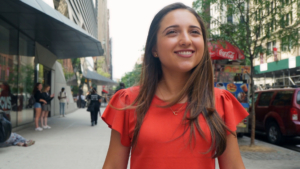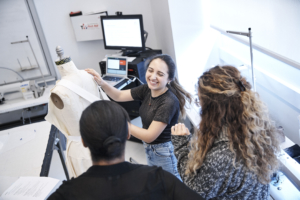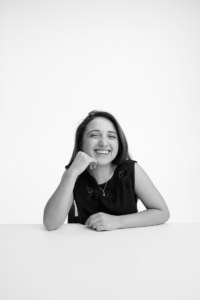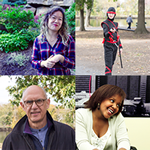Faces Behind the Screen: Camila Chiriboga
Quick Links
<< Return to all “Faces Behind the Screen” stories
Part 1
I was always interested in arts and crafts. I didn’t do a lot of drawing, but I loved pottery and jewelry making. I would get old jewelry, take it apart, and create new pieces.
My dad works in the fashion industry. He owns a factory in Quito, Ecuador, where I’m from. I would take spare buttons and make earrings out of them. That was my first mini-business, and I would sell it to all the girls in my class. I enjoyed making jewelry and I was so happy because they would always request for more.
My interest in fashion started early in life. I would always run around my dad’s factory. The ladies that worked at the machines would stitch clothes for me. Eventually, when I was eight years old my parents gave me a tiny sewing machine. It was the best gift ever!
Whenever I told my dad I wanted to pursue fashion, he would always say it was a fad and that it would go away. Every summer, he’d put me into a three-month-long pattern-making program. I was the youngest one in the class. Most of my classmates were 25 to 40 years old. Sometimes I would get so frustrated because I didn’t know how to properly create the patterns that I would cry. But I still loved it. Even while I was crying I would be pumped to go back the next day.
Over time, my dad understood that my love for fashion wasn’t going away. He told me that I could go to fashion school, but under one condition: I also had to study business just in case anything happened.
It was a complete dream to go to Parsons, and I never even thought they would accept me. My friend and I wanted to go so I was like let’s just apply just in case we get in. The worst they can say is no. So we spent the whole summer working on our portfolio together. And they eventually accepted us! We were both blown away. I started at Parsons School of Design studying fashion design and creative entrepreneurship.
There was a moment in my life when I was hospitalized for three weeks. I always loved dressing myself, and when I was in the hospital I couldn’t do it independently. I didn’t feel like myself. I wanted to at least look good on the outside even though I was in pain on the inside.
It was so different for me being completely vulnerable like that. It was okay because it was just a few weeks, but for so many people, it’s their everyday life. They have to rely on people to help them get dressed. This is where my passion for making clothes that will positively impact the way people live their lives started. I knew that clothes should be designed in a way that everyone can use them.
One of my first collections were for people with diabetes. After my hospital experience, I went to my fashion teacher and said, “I want to design clothing for people with disabilities.” He told me it wasn’t a good idea, because if it was a good market, someone would have already done it. There were already clothes made for people with disabilities like hospital gowns and clothes for the elderly, but they don’t have fashionable ones for young and middle-aged people.
I had two friends who were diabetic. I talked to them and they told me about their experience of how in the wintertime they had to take everything off to get their insulin injection, or how they had to carry their medication under dresses and they would always fall at parties. They would go to the bathroom and be uncomfortable.
One day I showed my work to a classmate and he started crying. It wasn’t a painting that usually moves people. It was just a jacket, pants, and a t-shirt. He told me that he was moved to tears because his grandfather never left his house because he was so depressed. He left work because he couldn’t put on his own clothes properly and had to wear a gown. My classmate told me that my clothing could’ve given his grandfather a life. I never knew how meaningful fashion could be.
The fashion industry seems like an industry that looks down and judges others. We see things in magazines that tell people they aren’t enough. But I want to use fashion in another way. I want to help people be themselves, express themselves, and be more independent and confident.
Part 2
Clothes can make us feel beautiful, but I think they can do so much more.
I started volunteering at a center called VISIONS for the Blind and Visually Impaired. I realized there how blind individuals experience fashion completely differently. Sometimes they would describe clothing through memories or how it made them feel. When I went there every week, I talked to teenagers and adults and it was mind-blowing to see a whole different experience of life. Usually, designers like to design with themselves in mind because they can experience it. But, I felt kind of like an anthropologist learning the experience of others.
When I visited the Perkins School for the Blind in Newton, MA, I scheduled a meeting to have a tour and speak with someone. I told them I wanted to start a collection for the blind, and they told me, “this is really not positive. Instead of creating something only for us, why don’t you create something beautiful for everyone, and then you can sell it to us?”
The point is not to sell to one group or another. It’s about making dressing every day a better experience. I didn’t want to dictate what blind people needed for clothing. I stayed very tied to the people I was working with, visiting them at least once a week. I didn’t want to imagine what they needed. Instead, I wanted the blind and visually impaired community actually telling me about their experiences. Then, I would translate their ideas onto paper.
I learned that for a lot of blind people, they lacked independence when choosing what to wear. A lot of people have their moms or assistant choose what they wore. There’s this one guy that I worked with the most, and I love him. His name is Gus Chalkias and we’re super close friends now. He told me once, “just because I’m blind, it doesn’t mean I don’t have favorite colors. It doesn’t mean I don’t have style.” It was awesome hearing him describe colors and how his dream was to have electric blue pants. He’d tell me the best thing is reading colors off of the color palette for paint because they have cool names. He would always ask me to read him the colors and he would tell me how he wanted to feel that day.
My professors at Parsons would tell me to put Braille on all of the clothing, but not every blind person knows Braille. I wanted my clothes to be something anyone can use, not just for the blind and visually impaired. That’s why I decided to use texture. Every color on the clothing had to have a different texture. So tactically, anyone could identify the colors that were visually displayed.
Usually, when I show people my collection, I have a lineup, I have photos, and I have my mood boards. I quickly realized that this was useless if I wanted to show my collection to blind individuals. I had to go back and ask myself, “how do I share my designs without someone seeing it?” I started to use more descriptive language, and I learned laser cutting techniques and 3D. If I wanted to communicate the mood of my collection, I’d play sounds to create a feeling when the garment is worn.
I also had to do a ton of textile testing. The people I worked with taught me how to use materials in different ways. I even incorporated technology into my design to help with navigation. I tested out Lechal for shoes because they have vibrations on the feet to help with navigation.
Some features I included in my designs was making everything reversible. There isn’t a right or wrong way – you can wear them anyway and the colors would be different. I also wanted to make sure that everything matched. If it was business attire or casual, everything matches. So there are no concerns about choosing something that’s mismatched.
I worked with the Accessibility Director at Google who has experience with describing artwork. So he helped me describe fashion in a more descriptive way. I realized that there is a hierarchy of needs. The tags would tell you the color, what the garment is, how to wear it, and how to take care of it. The shoes I designed looked like native Ecuadorian shoes. I had someone in Ecuador create them for me and put the technology in it. The shoes didn’t look super techy because I didn’t want them to look like a device – like wearable technology.
It’s so cool once the people I worked closely with tried the clothes on. I eventually made my friend Gus electric blue pants and he loved them! We were walking down the streets of Manhattan and he would go up to random people and talk about his pants. He felt very special to have clothes tailor-made just for him.
Part 3
I booked a photography session and it was amazing. It was much better than I ever thought it could be. The photographer never worked with blind models before. He took his time to ask questions and get to know the models.
Since he couldn’t visually show them how to pose, he got creative and instructed them to do different movements. He would say, “Look at the bird in the sky. It’s twirling around. Start twirling and looking at it. Now point at it. Now try to grab it. It’s going away.” The models would move in these amazing poses. Most photographers would move the models in a pose they liked, but it wasn’t natural. With this photographer, it was as if the models were dancing. They loved it.
It can be challenging designing clothes for someone that doesn’t have the same lived experience as me. It’s usually like: oh, I like this color, I like this texture, or I like how this looks on me. But when you’re designing for someone else, you might not have thought of a particular color or design that can make someone else feel happy. It’s about balancing what someone else wants while creating something unique.
I think it’s perfect timing to be at Parsons doing what I’m doing. When I first presented my idea to my teacher, he thought I was crazy. Now it’s innovative to be inclusive of other people – racially, physically, culturally, etc. It’s the right time for inclusion. I went to different exhibitions on access and ability. I was apart of a project to redesign the hospital gown. My Open Style lab taught me how to work with people and how to design for people with disabilities. I’m happy that the fashion industry is starting to adopt inclusion. It’s important to ask how do you design for others, not just the ideal person, but actual real people with real experiences?
Inclusion starts at the beginning of the design process. It shouldn’t be an afterthought. When you interact with someone that’s different from you, rather than being like, oh, that’s not something I would do, you begin to understand their unique experiences. It’s becoming more popular to design for the user which is important because you can’t imagine how someone else lives or works. It’s also just as important to include these people on your team. They should be on your team designing and giving ideas.
I feel very privileged to go to fashion school and do something I love while using the tools I’ve learned to help others. It’s typical to go to fashion school and make that collection that goes viral and has to be on all the models and catwalks. But I believe that breaking those boundaries are harder. To me, it’s more than saying a collection is cool. It’s about moving the industry forward and finding smart and innovative ways to help others.
The photoshoot was one of my proudest moments. The Parsons thesis is a really, really big deal. Every student wants to end up in the final show, and only 20 out of 400 students are selected. Of course, I wanted to be selected. I would be recognized and win money. I would be able to pay my dad back for all the money he spent on my materials. I was so stressed to make sure that the photoshoot came out well. I wanted to prove myself.
After the photo shoot, I saw how happy the models were. The photographer was blown away. The models called me the next day crying and thanking me. I was like, if nothing happens from this, at least we’re all happy. We had the time of our lives and we’ll never forget it. When you enjoy what you do, others will feel that. That was the best part for me, and the pictures from the photoshoot ended up being successful!
Faces Behind the Screen would like to thank Camila Chiriboga for participating in our storytelling project. If you’re interested in sharing your story with us, fill out our nomination form.
Faces Behind the Screen is a storytelling project focusing on members of the Deaf and hard of hearing community.






